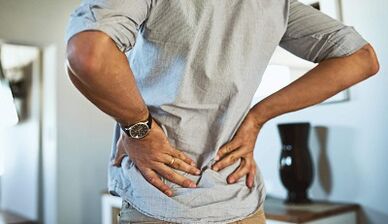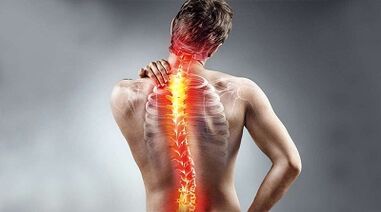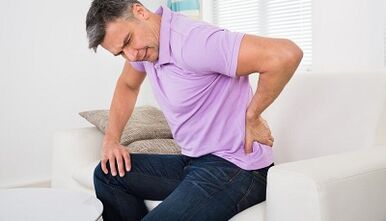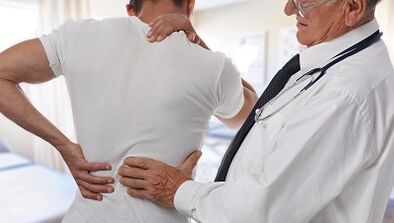
Back pain can occur at any age, but occurs more often between 35 and 55 years.The pain in the spine is associated with how our bones, muscles, intervertebral discs, ligaments, tendons and nerves work.
The pain in the spine can be caused by problems with the vertebrae, slices between them, tapes around the spine and panes, spinal cord and nerves, back muscles, the inner organs in the abdominal and pelvic areas.In addition, diseases of the aorta, tumors in the chest and inflammation of the spine in the upper back can be the cause of the pain in the upper back.
Risk factors
The presence of risk factors increases the likelihood of developing a state.For example, obesity significantly increases the risk of diabetes of the second type.
The following factors are associated with an increase in the risk of back pain.
- Office work;
- Working in connection with constant stress;
- Pregnancy - pregnant women often suffer from pain in the spine;
- sitting lifestyle;
- Age;
- Depression;
- Obesity/overweight;
- Smoke;
- severe physical exercises;
- Heavy physical work.
Signs and symptoms of back pain
The symptom is what the patient feels while the doctor notices the sign.For example, pain is a symptom while a rash is a sign.
The main symptom of pain in the spine is pain in every part of the back.Sometimes the pain extends to the buttocks and legs or shoulder and arms.
You have to contact your doctor immediately if the pain in the spine accompanies one of the following signs:
- Weight loss;
- High temperature (fever);
- Back pain is not relieved after rest;
- Painful pain;
- Pain abandoned under the knee;
- the presence of a fresh spine injury;
- Urine incontinence (even a small part);
- Difficulties in urinating - urine is difficult;
- Stool incontinence - loss of control via the defecation process;
- Daubiness in the field of genitals;
- Dust in the anus;
- Dust in the buttocks.

Apply for the advice of a specialist if you are one of these groups:
- People under 22 or older than 55 years;
- Patients who took steroids for several months;
- Cancer patients;
- Patients who once had cancer;
- Patients with low immunity.
The causes of back pain
The human spine is a complex structure that consists of muscles, ligaments, tendons, slices and bones.Intermediate spells are located between every pair of vertebral and fungi as a shock absorber of friction.Problems with one of these components can lead to pain in the spine.In some cases, the causes of pain cannot be determined.
Stretching
The most common causes of pain in the spine are:
- stretched muscles;
- Stretched ligaments;
- Lift a heavy object in the wrong pose;
- Lift too heavy object;
- the result of a sharp and unpleasant movement;
- Muscle cramp.
Structural problems
The following structural problems can lead to pain in the spine:
- Protection of the intervertebral disk.The fracture of the outer shell of the pane means that the inner content fell on the outside.This can lead to priests of the nerve and consequently pain;
- A hernia of the intervertebral disc- stinging the inner content of the disc of large sizes;
- sciatica- Acute and shooting pain that radiates on the buttocks and the rear area of the leg, which is caused by the lead or hernia of the intervertebral disc and compresses the nerve;
- arthritis- Patients with osteoarthritis usually have problems with the joints of the thigh, the lumbar spine, knees and hands.In some cases, a stenosis of the vertebral canal can occur because the room is narrowed around the spinal cord;
- Anomal bend of the spine- If the spine bends in an unusual way, the patient suffered more from pain in the spine.An example of an abnormal bend is scoliosis in which the spine bends to the side;
- osteoporosis- The bones, including the vertebrae, become fragile and porous, which leads to an increase in their fragility.

In the following you will find some other causes of pain in the spine:
- Syndrome of the horse's tail- The ponytail is a bunch of nerve roots in which the spinal cord is branched.People with a horse -tail syndrome feel blunt pain in the lumbar spine and in the buttocks.There can also be a loss of the sensitivity of the buttocks, genitals and thighs.Sometimes people suffer from urinary and/or feces with a horse -tail -cock syndrome;
- Spine- The tumor in the spine can squeeze the nerve, which leads to pain.
- Spine infection- If the patient has a high body temperature and also has a painful hot area on the back, this can indicate the infection of the spine;
- Other infections- Inflammation of the pelvic organs in women as well as infections of the bladder and kidneys can also cause back pain.
- Sleep disorders- People with sleep disorders have frequent pain in the spine in relation to the general population;
- Belt rose- infection that can affect the nerves;
- Inappropriate mattress- If the mattress does not support certain parts of the body and does not guarantee the even position of the back, there is a risk of developing pain in the spine.
The cause of pain in the spine can also be certain movements or body positions, such as:B. longer driving, coughing and so on.
What to do when back hurts
If you have pain in the spine for several days, you can help the following tips to reduce pain and symptoms and accelerate recovery:

- Remain active as possible;
- If necessary, use the pain reliever rank;
- Use hot and cold compresses.A bottle of hot water and a bag of frozen vegetables are made.
Despite the fact that it is difficult to stay an optimist if you suffer from pain, try not to lose your heart.This accelerates the restoration process.
With longer pain in the spine that does not pass within six weeks, you have to consult a doctor.The doctor creates a medical history, carries out an exam and directs it to additional studies if necessary.In the event of a problem, the doctor can prescribe a radiography with a bone system or arthrosis, CT (computer tomography) or MRI (magnetic resonance imaging) if the problems associated with soft tissues or nerves are suspected.In such a situation, MRI is the best choice.The doctor can also advise you to hand over some laboratory tests or measure the electrical activity of the nerves (EMG).
After a diagnosis, the doctor prescribes treatment.In most cases there is sufficient conservative treatment, including:
- special exercises;
- Reflex zone massage;
- Spinal expansion;
- Massage.
In severe cases, the question of the operation can be raised.The surgeon helps you choose the corresponding method and also advises on possible complications.Treatment of the spine is recommended some time after operation.Remember that the spinal operations are quite dangerous because the operating area is in the immediate vicinity of the nerves.

















































